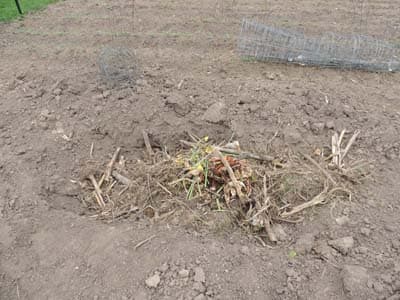Composting Techniques - Compost Honey Trenches

About Composting Honey Trenches
A compost “Honey Trench” is a long, deep trench dug in your garden, that is filled with raw compostable materials. The compost is covered with a layer of garden soil. A row of plants is grown over the honey trench. Burying compost in a trench provides row crops with rich, organic minerals an nutrients.
The concept of a compost honey trench is simple: Bury a mixture of compost where you will place a row of vegetable plants. You can add manure to this rich mixture, too. As the plant’s roots grow in search of moisture and nutrients, your plants reach and feed upon the rich compost and manure. By the time the plant roots reach the compost, it has decomposed. The valuable minerals and nutrients are ready to be taken up by your plants.
Note: Bury raw compost in the fall, or early in the spring. It decomposes underground during the winter.
Similar to the compost “Honey Hole”, a compost trench is a composting technique where compost is buried underground. Plant a row of your favorite vegetables in the garden soil above it.
By burying compost, you are also practicing a method of worm composting. The buried compost attracts worms in your garden, further aiding in the decomposition process. Along the way, they will leave worm castings, which in turn, feed your plants. Also see: Vermicomposting
How to Make a Composting Honey Trench
A Compost Honey Trench is best started in the fall, using raw compost materials. If you make a honey trench in the spring, use decomposed, finished compost.
Begin by digging a trench where you want to grow a row of flowers or vegetables next spring.
Dig the trench 1 to 2 feet deep.
Put raw, un-decomposed compost material. Put the materials inside the trench in layers. If you have manure, use a layer of that, too. The final layer should be 3 to 6 inches of garden soil. The finished trench should be mounded slightly. It will compact over time. In the meantime, the mound will allow excess water to drain off and away.
To mix or not to mix – If you use the layered approach above, mixing the materials is not necessary. If you feel better about mixing the materials first, go ahead and give it a few turns. There is no right or wrong way to mix materials. A pitchfork is helpful, to turn and mix materials.
By spring, the material in your compost trench has decomposed. You can plant flowers or vegetables right over the compost honey trench.
Additionally, this technique keeps varmints from overwintering in the compost pile.
See What to Compost
Related Articles
People who like this article will also like:
How to Make a Compost Honey Hole
Raised Bed Garden Soil – it’s a similar concept.
Please support our site. Shop for:
- rmmatthews100@hotmail.com
- 585-721-6528
- Rochester, NY
©1999-2024 GardenersNet.Com, All Rights Reserved

